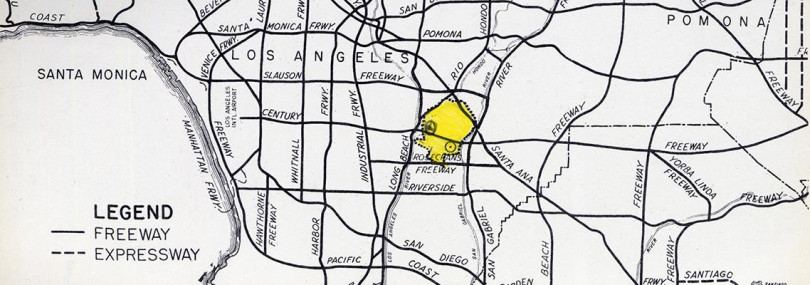
The city of Downey in California can be located on the map by its yellow marking and is bordered by the Santa Ana Freeway to the east and the Long Beach Freeway to the west. Downey was one of the cities in Southern California that invited Walter O’Malley to build Dodger Stadium there if a location in Los Angeles could not occur.
Feature
Downey Dodgers
By Robert Schweppe
When you say the team name “Los Angeles Dodgers” there is a great sense of familiarity with the term. The team is as much a part of the city as the city is with the team.
However, how would it have sounded if they had been the “El Monte Dodgers”? Could you say the “Torrance Dodgers” just as easily? The “Downey Dodgers” are alliterative, but would have you gotten used to saying it?
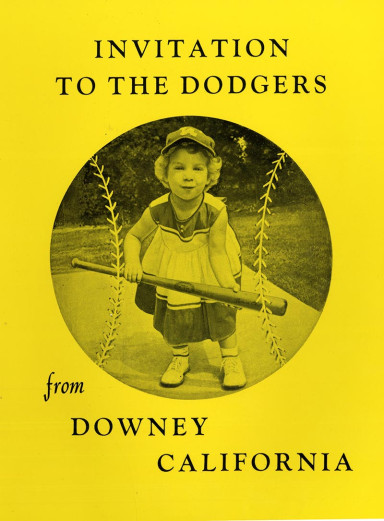
A young Dodger fan from Downey, California wears her “LA” cap and tries to bunt her way on to convince Walter O’Malley to locate a new baseball stadium in that city. The photo was on the cover of a printed document entitled “Invitation to the Dodgers from Downey, California.”
You can play the “What If” game with the Dodgers because when they came west to Southern California, there were more cities than just Los Angeles that had a tremendous interest in the team building their new stadium in their area. Dodger President Walter O’Malley had brought the team to Los Angeles in October, 1957, but he was now faced with a local referendum in June, 1958, “Proposition B”, as to whether the contract previously approved between the city of Los Angeles and the Dodgers that permitted an exchange of land to build a baseball stadium would be affirmed by Los Angeles city voters. The Dodgers received tremendous local support for the contract, but it was clear that opposition to the contract would be fierce. Observing this critical election, other Southern California cities reasoned the team might have interest of the potential their city would have should the contract with the city of Los Angeles and the Dodgers not be approved.
The greatest interest in the Dodgers was shown by the city of Downey, California. The city is named after the Governor of California during the Civil War and as its brochure announced, “Downey is a beautiful residential community located only 20 minutes from downtown Los Angeles. The area is an enviable one in which to live because of its ideal location, temperate climate, and fine modern homes with numerous private swimming pools.” The city was a finalist in the All-America City competition conducted by the National Municipal League. Current Mayor of Downey Scott Temple wrote in his letter to the citizens of Downey that “Downey will have a FUTURE UNLIMITED.”
The city published an informational guide “Invitation to the Dodgers.” The brochure included a letter from Mayor Temple to Walter O’Malley and the mayor’s letter stated, “We sincerely believe it will be to your advantage to thoroughly consider our proposed location and we extend our best wishes for your future.”
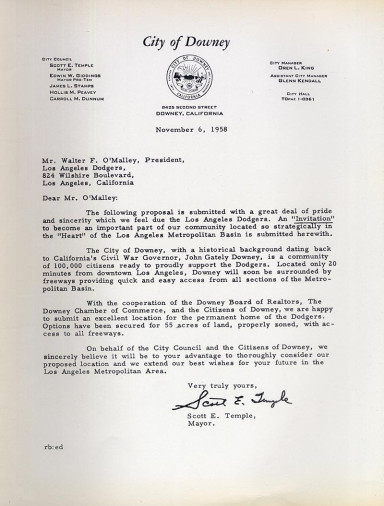
Scott Temple, the mayor of Downey, sends a letter to Walter O’Malley on November 6, 1958, making an invitation to have a new baseball stadium built in the Southern California city. The city of Downey felt they had an excellent location to build a stadium and conveyed a formal invitation to the Dodgers.
The Downey brochure to the Dodgers included endorsements for the city from Los Angeles First District Supervisor Frank Bonelli and an invitation and letter of support from Leon Emerson, President of the Downey Chamber of Commerce. James Hall, the President of the Downey Board of Realtors also provided good wishes and a message of support that Downey would be “the future home of the Dodgers.”
The city of Downey listed five reasons why the Dodgers should build their new stadium there. They pointed to their geographical and population center of Los Angeles, the increase of freeway mileage with all roads connected to Downey, the growth and progressive community of their citizens, the ease of acquisition of suitable land for a stadium, and the number of sports-minded fans in Downey who would support the Dodgers.
Maps with overlays showed the population distribution of Los Angeles County and the location of the stadium site within the center with its nearby connection to Southern California freeways. The final display in the brochure showed a section of land at Imperial Highway and Dunrobin Avenue as having great potential for a stadium.
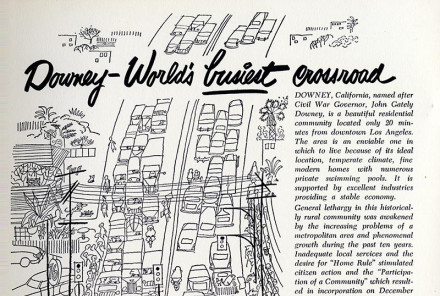
A whimsical rendering of the busy and family activities that can be found in the city of Downey was part of their printed document to invite the Dodgers to build a baseball stadium in their city. The artist was clever enough to work into the drawing a “Union 76” sign, one of the earliest sponsors of the Dodgers and an important financial supporter of Dodger Stadium.
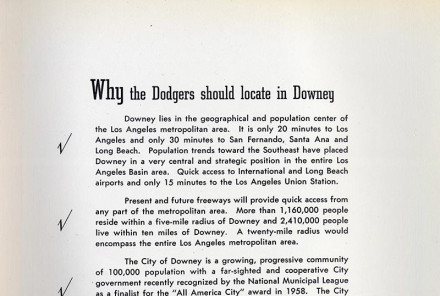
The city of Downey presented a full page of reasons why the Dodgers would be welcome to build a new baseball stadium there. Factors the city listed would be of value to the team and their fans included: a geographical center to Southern California; an available freeway system that was expected to expand; suitable population with regular growth; available land; the family reputation of the city; growing recreational interest in all sports.
Several other cities in Southern California joined in and showed tremendous interest in having the Dodgers build a new stadium in their city. Compton, California, the childhood home of future Hall of Fame outfielder Duke Snider, provided a large map showing a location between the present day 91 Artesia Freeway and the 405 San Diego Freeway where Major League Baseball could be played.
A real estate agent in Beverly Hills had sufficient land in the city of Torrance on the west side of Hawthorne Boulevard and as the agent put it, “just 10 blocks south of the, soon, to be built, Los Angeles-San Diego Freeway, the 405.” The land in Torrance was offered for $20,000 per acre. However, the real estate agent did admit it would require five parcels of land, and three parcels had just verbal commitments for sale thus far.
The same Beverly Hills real estate agent had land in Culver City he claimed was zoned for commercial recreation. The land consisted of 260 acres that was formerly the home to two golf courses in Fox Hills. As an incentive to Walter O’Malley, the agent claimed the land parcel that was unused for the stadium could always be sold to other businesses. The agent added in his letter, “We would like to keep this deal for you.”
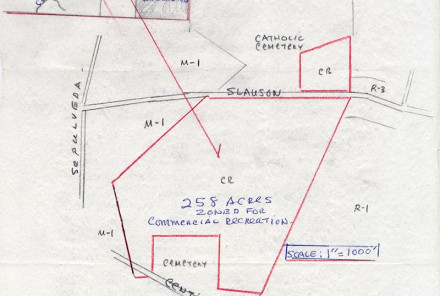
A map details a location for a new baseball stadium that would have been very close to Los Angeles International Airport. The land, offered by a real estate broker, was in the Fox Hills area of Los Angeles near the San Diego Freeway, just north of the airport.
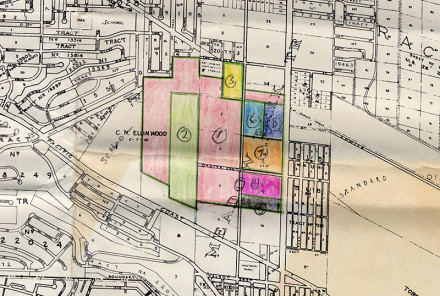
A real estate broker claims to have eight parcels of land available in the city of Torrance for the location of a new baseball stadium in Southern California for the Dodgers. However, the broker admitted to having certainty on just two parcels, a verbal commitment on three parcels, and the remaining three parcels required negotiation.
Norwalk, known as the “Keystone City”, sent an invitation by the Norwalk Chamber of Commerce to the Dodgers to come play there. The Executive Secretary of Norwalk’s Chamber of Commerce added their area of Southern California had “meant a great deal to two other Walters”—Disney and Knott for their amusement parks, Disneyland and Knott’s Berry Farm and that Walter O’Malley coming to Norwalk would complete “a successful triumvirate.”
Fletcher Aviation Corporation offered their support for land for a baseball stadium in Rosemead. The stadium would be bordered by Rosemead Boulevard and the San Bernardino Freeway.
Another real estate agent had an idea for the Dodgers to combine their baseball stadium with a race track. The agent’s idea was to place the baseball stadium in Santa Anita where the agent claimed there was public transportation and “more parking space than the Coliseum and the Rose Bowl put together.” The agent even had practical ideas how the stadium could be fitted into the race track. “Just put up a wire fence around your outfield and set up temporary bleachers.” The agent was optimistic it could be done. “The Racing Season at Santa Anita ends before the Baseball season, so there is no problem” according to the agent. The same agent also had, as what he said was, the “perfect site” for Walter O’Malley to live at the former location of the greenhouses of the Botanical Gardens. There was an available 2 ½ acres, room for a large house and pool, and room for 12,000 to 15,000 cumbidium orchid bulbs worth more than $75,000!” The agent concluded “knowing that O’Malley is an orchid fancier, I felt this was for him!” It wasn’t.
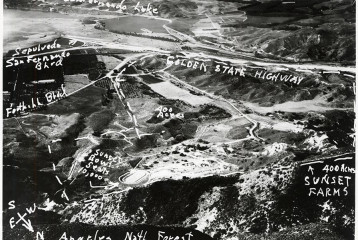
An aerial photo of land in North Hollywood near the Angeles National Forest is proposed by someone for the location of a new baseball stadium in Southern California. The person submitting the location said the land was a mixture of granite and clay that could easily be moved to form a “natural” bowl for a baseball stadium.
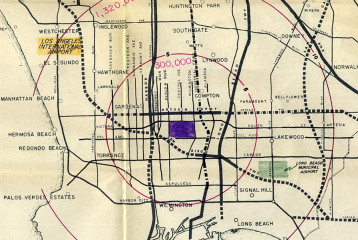
A purple rectangle marks a spot between the cities of Compton, Lakewood, Long Beach, Torrance, and Gardena for Dodgers’ new baseball stadium. The numbers inside the radius of the circles on the map indicate the estimated level of population that would be near the proposed site of the stadium.
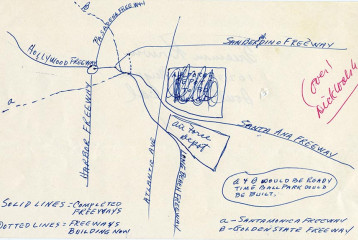
A baseball fan attempts his effort at drawing a map to locate a new baseball stadium in Southern California for the Dodgers. The proposed site would have been a United States Air Force Depot in the city of South Gate.
Fans all over Southern California were also interested in providing solutions for O’Malley for a baseball stadium. One fan wrote in to say thirty minutes from downtown in the northwest part of town was a location to be reached by five freeways. The fan added at the end of his letter, “Keep me in mind.”
Another fan wrote to O’Malley and asked him to “Read slowly—well,” and then queried O’Malley if there was enough land owned by Universal-International in Studio City for a stadium. The fan wanted O’Malley to know everything was on the hush-hush with him as he wrote O’Malley, “Check that. I heard a rumor.” The Universal land later became much of Universal Studios.
One fan had a stadium location site, but also a complaint. He recommended a place south of the San Bernardino Freeway and claimed he would get help from the Long Beach Freeway connecting to the San Bernardino Freeway. After offering this advice, the fan added that at a recent game at the Coliseum, he wanted to buy a scorecard, but the program hawker would not sell a program unless the fan would buy a five cent pencil. The fan already had three pencils with him and wanted to know if this was team policy that you had to buy a pencil with the scorecard. Actually, it was not.
A real estate investor said the sale of property near Hollywood Park would be a place for a baseball stadium. The investor raved about the sufficient room, the available transportation, it was outside smoggy areas, and best of all, the use of Hollywood Park parking lots would be available.
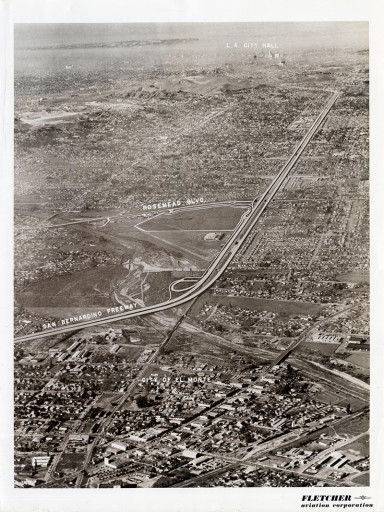
An aerial photo from the Fletcher Aviation Corporation offers available land for the Dodgers to build a baseball stadium in the city of El Monte. The particular site for the Stadium is outlined just off the San Bernardino Freeway.
One fan wrote in to say he had a friend who owned 180 acres of dairy land in the South Bay area. Other locations in Southern California that were suggested to the Dodgers were the city of Maywood on the site of a former United States Air Force supply depot. Fans mentioned other areas as locations for a baseball stadium were Exposition Park, Artesia, North Hollywood, Manhattan Beach, Studio City, Quartz Hill, and El Monte. All these fans promised available land for a stadium, room for parking lots, easy access by freeways, great weather, and citizens favorable to having the Dodgers in their city.
A member of the Manhattan Beach Chamber of Commerce wrote boldly “the potential here, from our point of view, is much greater than your original thinking of Chavez Ravine.” The city even completed a resolution dated January 21, 1958 that “the City Council of the City of Manhattan Beach that previous and future activity and efforts of its Chamber of Commerce to make major league baseball a reality in our community is endorsed.”
Municipal interest in the Dodgers playing games with a baseball stadium in their city extended southward to Orange County. Buena Park Mayor Dennis Murphy called to say there was available land in his city for a stadium. City Clerk James Black of Westminster wrote O’Malley that “Our small community can and will provide the area necessary for the location of the Los Angeles Dodgers.” The City Clerk added the advantages of Westminster were available land, central geographical location for Southern California and sufficient freeways that ran through and by Westminster. In addition, the City Clerk said, “The attitude of the community is very cooperative. Furthermore, you could still use the same name.”
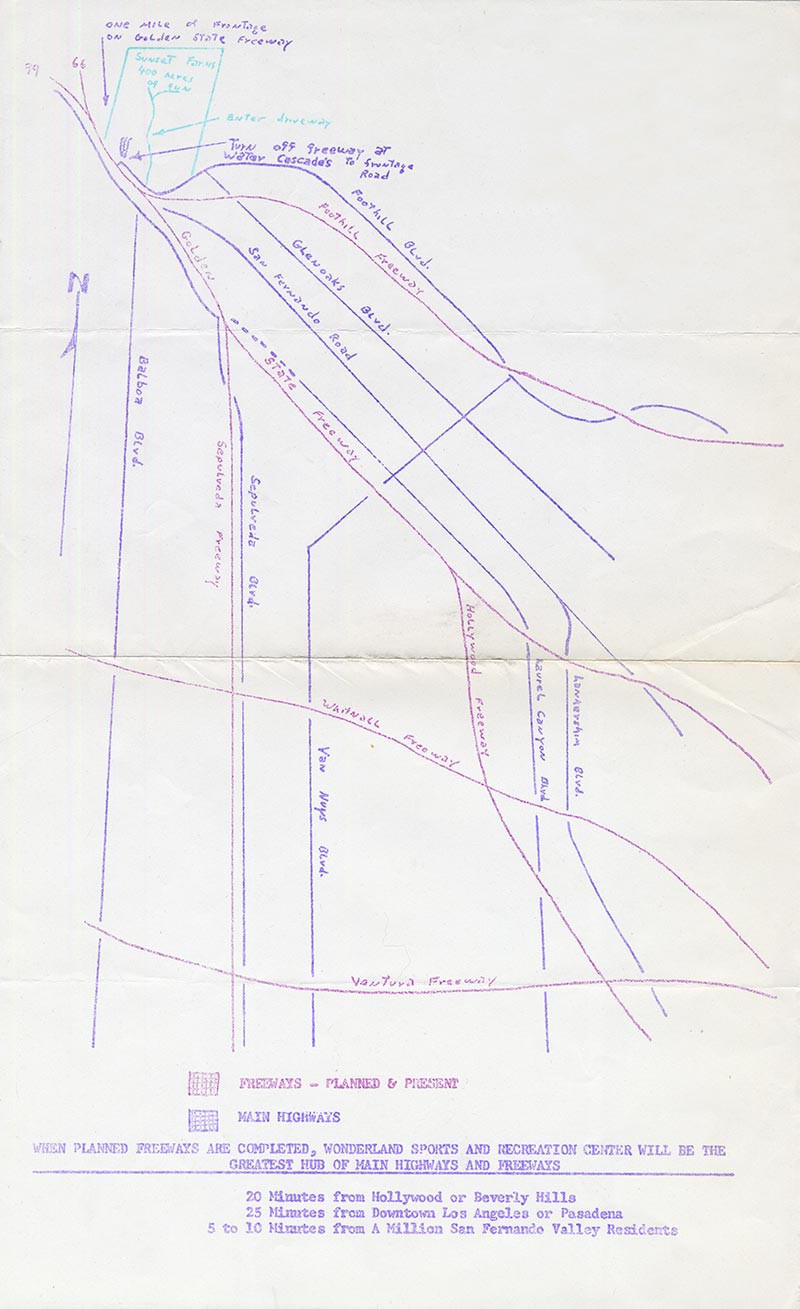
A map displays 400 acres of land in North Hollywood for a new baseball stadium. The various lines show main transportation routes that would be used for access to the ballpark. At the bottom of the map, it proclaimed “When planned freeways are completed, Wonderland Sports and Recreation Center will be the greatest hub of main highways and freeways. The map also mentioned the ballpark location would be 5 to 10 minutes away from a “Million San Fernando Valley Residents.”
How close would any of these cities have been able to host the Dodgers? Actually, the chances were not as high as the cities would have liked. In a letter written by National League President Warren Giles on December 19, 1957, Giles warned O’Malley that the National League permission for the Dodgers to play in Los Angeles extended only so far as Los Angeles and that playing in another city might keep the Los Angeles territory open.
Giles wrote in his letter, “Press accounts indicate you will negotiate for the right to play some or all your games in the Rose Bowl, which I understand is located in the city limits of Pasadena and of course outside the city limits of Los Angeles. There are two problems confronting us on that; one is very, very important. It is my belief that unless you would play a substantial number of your home games in a park located within the city limits of Los Angeles, the National League could not be considered as occupying Los Angeles territory in 1958. The other problem is, your club is considered to be the Los Angeles member of our league (or at least it will be when arrangements are finally completed) and therefore if you wanted to play a limited number of games outside of Los Angeles, league consent is required, just as it was in the Jersey City situation…..To play all of your games outside of Los Angeles would, in my judgment, leave the Los Angeles territory open and I am not sure but that some club might under our rules be able to move into Los Angeles, and probably at no cost to them. This would confront the league with a serious situation.” Giles concluded his letter to O’Malley with good wishes. “You certainly have your hands full but I feel confident you will be able to work it out.”
However, on June 3, 1958, Los Angeles city voters approved Proposition B, the contract between the city of Los Angeles and the Dodgers was valid, Dodger Stadium was built, and the Artesia-Buena Park-Compton-Culver City-Downey- El Monte-Exposition Park-Hollywood Park-Manhattan Beach-North Hollywood-Norwalk-Quartz Hill-Rosemead-Santa Anita-Studio City-Torrance-Universal Studios-Westminster team became known simply as “your Los Angeles Dodgers.”

